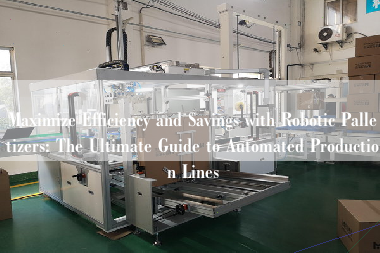Smart Factory’s Silent Movers: How Robotic Palletizers Reshape Production Lines
Core Drive Mechanisms Unveiled: Sensor-to-Robotic Arm Synergy
Yanmao Intelligent Equipment (Suzhou) engineers Robotic Palletizers around precision synchronization. Industrial-grade LiDAR sensors map package dimensions within ±0.5mm accuracy. Torque-controlled robotic arms adapt grip pressure based on material density feedback. This sensor-actuator handshake eliminates product deformation during handling. Vibration-dampening mounts maintain stability at 30 cycles/minute. Ethernet/IP connectivity enables real-time data exchange with upstream Case Packers. Yanmao’s modular servo drives allow torque adjustments for fragile glass containers or rugged 55-gallon drums.
Workflow Panorama: Object Recognition→Precision Grasping→Intelligent Stacking
Infrared 3D scanners classify incoming cartons and poly bags at 200 units/minute. Machine vision algorithms distinguish between irregular shapes like pharmaceutical pouches and industrial drums. Vacuum grippers with adaptive suction cups handle corrugated boxes without crushing. For woven poly bags, Yanmao employs dual-claw mechanisms preventing slippage. Stacking logic follows ISO 6780 patterns, auto-adjusting layer height based on load center calculations. Collision-avoidance systems halt operations when human workers enter predefined safety zones.
Technological Evolution: From Fixed Patterns to AI Self-Learning
Legacy palletizers required manual reprogramming for each SKU change. Yanmao’s current-generation units feature neural networks that analyze historical stacking data. These systems optimize pallet configurations after three production cycles. Reinforcement learning algorithms reduce empty space between drums by 18%. Cloud-based pattern libraries enable cross-facility knowledge sharing. Food manufacturers report 40% faster changeovers when switching between carton sizes. Predictive maintenance modules alert technicians about wear in belt conveyors 72 hours before failure.

Industry Applications: Food/Pharma/Logistics Case Studies
Frozen Food Processor: Yanmao’s high-speed Robotic Palletizer handles -25°C operations, stacking 1,200 boxes/hour without lubricant freezing. Hygienic stainless steel construction meets USDA standards.
Chemical Manufacturer: Explosion-proof models transfer 55-gallon drums filled with volatile compounds. Intrinsic safety certifications include ATEX and IECEx compliance.
E-Commerce Fulfillment Center: Mixed-load palletizers combine cartons, poly mailers, and plastic pouches in single stacks. Dynamic weight distribution prevents toppling during transit.
Pharmaceutical Facility: Cleanroom-compatible units with IP65 sealing maintain sterile environments while packing medical device cartons.
Investment Decision Guide: The Cost-Benefit Equation of Robotic Palletizers
Initial Investment Panorama: Equipment/Installation/System Integration Cost Analysis
Purchasing Yanmao Robotic Palletizers involves three primary capital expenditures. Equipment costs vary based on payload capacity and customization, ranging from $85,000 for standard carton handlers to $220,000 for heavy-duty drum models. Installation expenses typically consume 15-20% of equipment value, covering foundation preparation, utility connections, and safety fencing. System integration represents the most variable component, with PLC/SCADA interface development adding $30,000-$60,000 depending on existing line architecture. Yanmao Intelligent Equipment (Suzhou) offers pre-engineered integration kits that reduce this cost by 40% for common packaging environments. Optional investments include thermal imaging systems for cold storage facilities or explosion-proof certifications for chemical plants.
Operational Cost Comparison Model: Long-term Ledger of Labor/Energy/Maintenance
Replacing manual palletizing operations generates immediate operational savings. A single Robotic Palletizer eliminates 2-3 full-time positions, saving $120,000-$180,000 annually including benefits in North American markets. Energy consumption averages 8-12 kW/h during continuous operation – approximately $6,000 yearly at industrial electricity rates. Maintenance contracts covering predictive servicing and wear components represent 3-5% of equipment value per year. Manual palletizing operations incur hidden expenses: worker fatigue reducing output by 15% during final shifts, overtime premiums during peak seasons, and recruitment/training costs averaging $5,000 per replacement worker.
Hidden Value Assessment: Quantifying Yield Improvement and Injury Rate Reduction
Product damage reduction provides measurable financial impact. Yanmao’s torque-controlled grippers decrease carton crushing incidents by 92% versus manual handling in third-party audits. Pharmaceutical clients report 0.03% rejection rate reductions translating to $250,000 annual savings on high-value products. Injury cost avoidance presents another dimension: OSHA data shows manual palletizing causes 12% of warehouse musculoskeletal disorders. Automated systems eliminate repetitive-strain claims averaging $35,000 per incident. Production continuity improves through 24/7 operation without breaks, increasing annual throughput by 1,200-1,800 hours in three-shift facilities.
Purchasing Strategy: Balancing Modular Configuration and Future Expandability
Yanmao’s modular design philosophy enables strategic investment scaling. Base Robotic Palletizer units accept three expansion paths: payload upgrades through reinforced arm assemblies, speed enhancements via high-frequency servo motors, and functional add-ons like automatic slip-sheet insertion. Food processors often implement phased deployments – starting with primary SKU automation then adding vision-guided mixed-load capabilities. Future-proofing considerations include Ethernet-APL connectivity for IIoT readiness and 20% power headroom for throughput increases. Standardized mounting interfaces allow relocation between facilities during production reconfiguration.
ROI Calculation: Break-even Points for Businesses of Different Scales
Investment recovery timelines vary by operational scale. Small enterprises (1-2 shifts, 50 pallets/hour) see 6-9 month payback periods when accounting for throughput increases and injury cost avoidance. Yanmao’s ROI calculator incorporates site-specific variables: local wage rates, energy costs, product damage history, and shift patterns. Most clients report 300-400% lifetime ROI over the 10-year equipment lifecycle.
